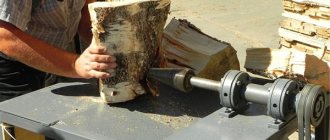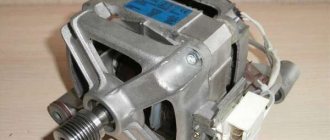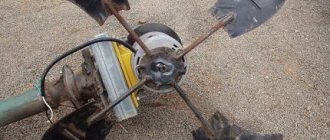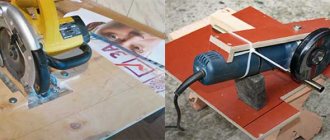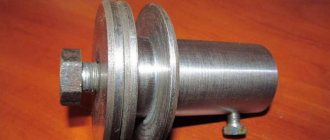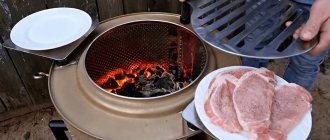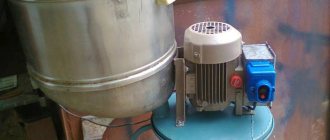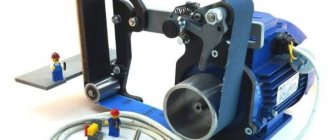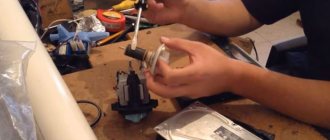Making a car with your own hands is a task worthy of a real man. Many people think about it, some take it on, and only a few bring it to completion. We decided to tell the stories of cars made, as they say, on the knee. We’ll talk about the work of professional body shops, including Russian ones, such as A:Level or ElMotors, another time.
The work of the masters of the East
What can an engine from an old washing machine look like?
If you are planning to make homemade products from a used engine, you need to figure out what it is and what it is capable of. In washing machines you can find three types of motors: asynchronous, brushless and commutated. Let's take a closer look at them:
- Asynchronous - can be two-phase or three-phase. Two-phase engines are found in older Soviet-made models. More modern machines are equipped with three-phase. The design of such an engine is extremely simple; it can reach speeds of up to 2800 rpm. The working engine removed from the machine just needs to be lubricated - and it is ready for new exploits.
Such motors are characterized by quiet operation. Their only drawback is their impressive dimensions.
- Commutator – you will find this type of motor in the design of most household appliances. Such devices can operate from direct and alternating current, have compact dimensions and a controlled speed. The only drawback of such an engine is the brushes that wear out, but these parts can be replaced if necessary.
It must be admitted that, in comparison with an asynchronous motor, such a motor is noisier. In addition, it often overheats and even sparks
- Brushless direct drive is the most modern motor from the Korean manufacturer. You will find it in modern washing machines from LG and Samsung.
Such models are the most compact. They are characterized by wear resistance, simplicity of design and high efficiency.
Now that you can determine the type of motor, all that remains is to decide where you can use the motor from the washing machine.
Foreign cars. Machine diagrams.
Chevrolet Camaro made of paper
Paper diagram of a Subaru BZR racing car
Mazda 2 car template
Mazda 3 car scan
Mazda 6 car template
Mazda Cosmo Sport car drawing
Mazda B-Fighter printable template
Mitsubishi Lancer Evolution car diagram
Mitsubishi Lancer Evolution X paper car drawing
Mitsubishi Outlander car diagram
Paper diagram of Mitsubishi Pajero Dakar
Mitsubishi Triton car
Paper model of Audi A3
Bobcat XL machine diagram
Citroën Ami 6 printable diagram
Citroen drawing
Daihatsu Terios car
Paper printout of FIAT 147
Paper diagram of FIAT 600
Ford Kuga car template
Paper Mercedes Benz printout
Mercedes-Benz e-class cars
Mercedes-Benz Lorinser
Mercedes-Benz W124 diagram
Mercedes-Benz W210 made of paper
We properly disassemble and decide what can be made from parts of an old washing machine
Disassembling a washing machine is a leisurely task. After working with water, a salt build-up may remain on the parts; it must be carefully removed so as not to damage the parts during removal. What can be made from an old washing machine? A motor will be useful for homemade projects - it will become the basis for many devices. The drum will also come into play. It is usually made of stainless steel. All pipes must be disconnected from the drum. A loading hatch may also be useful. In addition to these parts, do not rush to throw away springs, counterweights and body parts.
For those who are versed in electronics, you may need a circuit board - it can easily be used to find spare parts for repair work if necessary.
Why do I need it
I worked for 30 years at the Alagir resistance plant (North Ossetia - ed.) I came to production when I was 16 years old. During his work, he acquired several specialties: turner, milling machine, tool maker, operator of a surface grinding machine, cylindrical grinding machine, optical grinding machine, electrical discharge machine. As a result, the skills acquired were very useful.
Since childhood I wanted to build a car with my own hands. Not to assemble, like a designer, from parts and pieces of a specific model, but to build “from scratch.” I finally understood what I wanted when a catalog of the best cars in the world fell into my hands. There I saw the handsome Lotus Seven and fell in love. I decided that I would definitely make the same one, and with luck, it would be even better. But he began to implement his plans only eight years ago.
Lotus Seven
Help
The Lotus Seven was first introduced to the public in 1957 as a British club racing car. Since 1958, the roadster began to be sold in disassembled form, giving buyers the opportunity to assemble the car themselves.
Lotus sold the model until 1972, after which it ceded the rights to Caterham Cars, which still produces racing cars and kits for their self-assembly. Thanks to the simplicity of the design, enthusiasts around the world have created many cars in the style of the Lotus Seven.
A roadster is a two-seater, two-door car with an open top or a removable roof. This type of car appeared in the United States in the 1920s.
How to make a sharpener or grinding device from a washing machine engine
A sharpener is one of the most popular tools for the home. It can be used to sharpen garden tools, household knives and scissors. If you don’t already have one, buy it at any tool store or make a sharpening machine from a washing machine. The most difficult part is how to attach the sanding wheel to the motor. The easiest way is to buy a ready-made flange. It looks something like this.
Flange for motor
You can machine a flange from a metal pipe of a suitable diameter; most often, a tube with a cross-section of 32 mm is suitable. You need to cut a piece 15 centimeters long from it, this is quite enough to fix the emery. The flange is secured to the motor shaft by welding or a through bolt. The video describes in detail how a homemade washing machine sharpener works:
Homemade Rolls Royce Phantom from Kazakhstan
0
0
A separate area of creating homemade cars is the construction of cheap copies of expensive and famous cars. For example, 24-year-old Kazakh engineer Ruslan Mukanov built a visual copy of the legendary Rolls Royce Phantom limousine. While prices for a real Rolls Royce Phantom start at half a million euros, Mukanov managed to build himself a car for just three thousand. Moreover, his car is visually almost indistinguishable from the original car. True, this car looks very unusual on the streets of provincial Kazakh Shakhtinsk.
Making a wood lathe from a washing machine
What else can you do with the washing machine motor? One popular idea is a wood lathe. Let's look at the step-by-step process.
| Illustration | Description of action |
| To firmly fix the engine on the workbench, make fasteners from a metal angle. To do this, drill holes for fixing to the motor legs and table. | |
| To fasten a wooden part, you will need a flange fixed to the motor shaft, and these are the studs made from ordinary bolts with cut off heads. Screw these pins into the base. You will need 3 studs. | |
| The motor is fixed to the table with self-tapping screws and to the metal part with bolts. | |
| The opposite end of the wooden part is attached with such a device. It consists of a screw with a loop, two wooden stands perpendicularly fixed to the corners. | |
| This wooden part must be movable so that different workpieces can be used. For mobility, it is mounted on a threaded stud with bolts. | |
| To control the motor you will need a power supply. You can use one of the computer units. You will need to install switches to adjust the rotation speed. | |
| How to connect a motor to a power supply in animation. | |
| To guide your tools, make a tool rest. It consists of two wooden parts and a metal corner. All parts are movable due to fastening with one bolt. | |
| The lower part of the tool rest is rigidly fixed on the workbench using self-tapping screws and corners. | |
| The workpiece is fixed on the machine on both sides: on the left - on studs, on the right - on a bolt with a handle. To fix it in the workpiece, you need to drill the corresponding holes. | |
| To work, you will need sharpened tools - cutters. | |
| Final sanding of the workpiece is done using a strip of sandpaper. |
Body
Assembling the frame structure and connecting it to the engine, transmission and suspension is half the battle. What makes a car recognizable is its body. But even if I suddenly had an original Lotus body, I would fundamentally not merge it with my frame. It was important for me to do everything myself and in my own way.
The rear panel design has been redesigned several times
I had no experience, so I had to learn through trial and error, acquiring new skills. So, in the process of work, in addition to welding, I mastered sculpting and the basics of painting.
Now, by the way, I sometimes earn extra money by painting cars.
50 kilograms of plasticine went into creating the body
At first I wanted to make the body out of iron, but later I decided to go with fiberglass: I went to Moscow and the Moscow region to get it. First, I sculpted the body from sculptural plasticine - this is exactly how auto designers work in workshops. One piece of plasticine took 50 kilograms. It was necessary to achieve the desired shapes, to fit the parts one to another. Then, on this basis, he created a mold from fiberglass, and the final version was cast from it. It didn’t work out right away - there wasn’t enough information or experience.
As a result, I went a little overboard with the thickness of the plastic, and the frame turned out to be too powerful. At the end of the day, I got a car weight of 700 kg versus 540 kg for the Caterham Classic (basic modification) and 460 kg for the Caterham Superlight with a carbon fiber body.
How to make a simple feather removal machine for home use from a washing machine with your own hands
The time of slaughtering a bird is a troublesome stage. This is usually done in the fall, when the ducks and broilers have reached the desired weight, and it is no longer profitable to keep them in the winter. You need to pluck several dozen or even hundreds of carcasses very quickly. You can get rid of hard labor with the help of a feather removal machine, and it’s easy to do everything from the same parts of the washing machine.
The only thing that can cause difficulties is the search for rubber fingers with threads - beaters. You will have to order them, so keep in mind that you need to think about making the machine long before slaughter
The device does not require disassembling the washing machine. It is especially convenient to use machines with vertical loading. You just need to fix the beats in the drum so that they point inward. Before plucking, the chicken carcass must be scalded with boiling water and then simply thrown into a rotating drum. Here's what happens:
Important! To prevent water from getting on the engine of the feather removal machine, you need to protect it with a plastic casing.
And the last point - the feather removal device must be firmly fixed, since the vibration when loading the carcass will be very strong.
Super Awesome Micro Project - a homemade pneumatic car made from LEGO
0
0
The LEGO constructor is such a versatile material that you can even construct a fully functional car from it. At least this was achieved by two enthusiasts from Australia and Romania, who established an initiative called the Super Awesome Micro Project. As part of this, they built a car from a LEGO set that can move thanks to a 256-piston pneumatic engine, accelerating to a speed of 28 kilometers per hour. The cost of creating this car was just over 1 thousand dollars, of which most of the money went to purchase more than half a million LEGO parts.
Lawnmower from a used motor
We continue to look for the answer to the question of where we can use the motor from an automatic washing machine. Another original idea is making a lawn mower. For a small area, an electric model connected to a power source with a cord is quite sufficient. The design of such a unit is very simple. You will need to make a platform on four wheels with a small diameter.
The platform can be made of metal or OSB board, plywood and even the body of the same washing machine
The engine is fixed on top of the platform, the shaft is threaded into the hole below, and the knife is attached to it. All that remains is to attach handles and a lever to the cart to turn the power on and off. If you have an asynchronous motor lying around, you will be surprised at how quiet the unit will be, even compared to factory models.
Advice! To prevent grass from wrapping around the knives, you need to slightly bend their cutting edges down.
Video: how to make a lawn mower
Beginning of work
I built a small workshop to work on the car. Purchased equipment and tools. The engine was borrowed from Niva.
I decided to base the body on a space frame of my own design. The suspension parts were partially used ready-made, and partially made by myself: the steering knuckles were made by VAZ ones, the front and rear control arms were completely homemade. I also took the springs and shock absorbers from VAZ, but I had to make the fasteners myself. The steering rack is used from a VAZ-1111 Oka car. The mufflers are also my work: to make them, I had to master argon welding.
Special modules were purchased for the optics, which are used in bumpers, and the housings for them were again made independently. The taillights were cut out from monolithic plexiglass. Wheels and tires were selected according to size. Where did you get the finished parts? I went shopping and bought at the market. It was not easy to find the right one - the car is not a production line.
It happened that I took several different copies from sellers on parole, put them at home and looked at them. I left the suitable parts and returned the rest. It was difficult to fit all the units into the frame and at the same time provide a comfortable fit for the driver and passenger, without exceeding the specified dimensions.
I had never seen a Lotus in person, so I guessed some design elements intuitively. It’s easier to say that I took only the concept from the prototype - an open top, a front suspension placed outside the body, etc. But structurally, the car turned out to be completely original.
When I first rolled the car out of the workshop, my soul just sang! Indescribable emotions! Believe me, this is worth living for!
The first rollout of the “frame” took place six months after the start of work, and the remaining seven and a half years were spent creating the body and equipping it with the necessary accessories.
First rollout, 2012
How to build a generator from an old washing machine
We continue to look at homemade products from a washing machine motor, and the turn has come to the generator. You won't be able to assemble a powerful device, but in the event of an emergency shutdown, you can be well prepared. To turn the engine into a generator, you will have to disassemble it and partially cut off the core. In the remaining part of the core you need to make grooves for neodymium magnets.
The magnets must be placed in two rows with the same spacing
The gaps between the magnets are filled by cold welding. To operate the device, the kit must include a motorcycle battery, a rectifier and a charge controller. Details of the work in the video:
Lamborghini Reventon
Wang Jian's neighbors think the car he made looks like a Lamborghini Reventon and happily take pictures behind the wheel.
Wang Jian's neighbors think the car he made looks like a Lamborghini Reventon and happily take pictures behind the wheel.
As you can see, most of all do-it-yourselfers love to copy Ferrari and Lamborghini. Externally. Inside this car, designed by Mr. Meath from Thailand, is a quarter-liter Lifan motorcycle engine.
The funniest and most touching creation is by Chinese farmer Guo from Zhengzhou. He made a Lambo for... his grandson. The car has children's dimensions - 900 by 1800 mm and an electric motor that allows it to accelerate to 40 km/h. A battery of five batteries is enough for 60 km of travel. Guo spent $815 and six months of work on his brainchild.
Homemade concrete mixer
If you have started a small renovation that requires, for example, plastering the walls, a concrete mixer will come in handy. Once again, washing machine parts will come in handy.
As a result, you will receive a compact device with low power, which you won’t mind throwing away after the repair work is completed.
As a container for concrete, you can use the same drum with pre-sealed holes for draining water. It is best to use parts from a front-loading machine; there will be almost nothing to redo. To strengthen the body, use a metal corner, and for convenient movement of the concrete mixer, equip it with wheels. The main difficulty in the design is the manufacture of a “swing” for the correct tilt and subsequent pouring of concrete. How to do it correctly in the video:
It all starts with the wheels: what kind of all-terrain vehicles do craftsmen build and how do they do it?
There is such a competition in Russia - “All-Terrain Vehicle Trophy”. At the dawn of its formation, it was more like a festival of all-terrain vehicle lovers, which takes place in the Leningrad region. Over time, the status of the event has changed, and now it is an official sporting event. Its creator and ideological inspirer is Alexey Maratovich Garagashyan. The same man who at one time created one of the best all-terrain vehicles in the country (and maybe the whole world) - “Sherpa”.
Alexey Maratovich is a serious person. If anyone thinks that a big party of all-terrain vehicles is all about fun, bonfires and drinking, they are very mistaken. The All-Terrain Trophy is a very important competition with fairly strict regulations, and you can easily get kicked out of it for drunkenness. It is not surprising that only the most die-hard (in the good sense of this big word) all-terrain vehicle enthusiasts gather under Garagashyan’s strict leadership. And what I like about the “Trophy All-Terrain Vehicle” is the abundance of homemade vehicles. This is where the flight of technical thought knows no limits! The struggle of homemade products on the roads, in swamps, in forests, on water is a very interesting sight. And the all-terrain vehicles themselves are usually also extremely interesting, although, of course, some common features and layout schemes can be traced in them. Well, who, for example, has not tried to repeat the same side-turning Sherpa or Garagashyan’s earlier all-terrain vehicles (for example, DIF-4 Cheburator)? Many have tried. Some did quite well. And someone went their own way and built something completely incredible, which is even more commendable.
The same "Sherpa"
I have no goal of gathering all the all-terrain vehicles into one crowd and sorting them by type of design: this is probably impossible. But I will try to highlight at least four groups of wheeled, more or less typical designs. So that you can at least roughly understand how craftsmen build their cars and appreciate their work. As examples, I will give four all-terrain vehicles that at one time either impressed me more than others, or well illustrate the standard approach to constructing homemade products. Of course, a huge number of other wonderful cars will remain out of sight today, but if this material seems interesting to our readers, I will be happy to continue this topic. In the meantime, meet the first and most accessible type of homemade all-terrain vehicle - “breakdowns”.
"Not enough halves..."
“Perelomka” is the simplest design, typical of many homemade all-terrain vehicles. It gets its name from the type of frame, which is correctly called articulated. As an example of such an all-terrain vehicle, let's take the ZIS-178 - an all-terrain vehicle that is being built in St. Petersburg by two good comrades Roman and Dmitry.
Classic “breaking point” - ZIS-178
Now they build these all-terrain vehicles to order, and you can buy them in the basic configuration for pennies (within 300 thousand rubles), but it all started with the same creativity - building a homemade all-terrain vehicle. In my opinion, Roman and Dmitry are the second example in my memory of a successful attempt to make money from their hobby (the first is, of course, Garagashyan with his “Sherpa”). So the ZIS-178 is, of course, a homemade product, but it has already received serial status. This is such a pleasant incident.
So what is this all-terrain vehicle? It is based on a frame consisting of two separate sections: front and rear. These halves are connected to each other by a steering knuckle. In the case of the ZIS-178, this fist was taken from UAZ, but enthusiasts also use others. Here, usually whatever is found goes into use.
Steering knuckle in frame articulation
Since the all-terrain vehicle turns solely due to a frame fracture, a steering rod must be connected to the steering knuckle. You can also take any rod and rack that you can find at the nearest disassembly, and connecting them to the steering knuckle is not so difficult.
The steering wheel with EUR is from Polo
But then pure creativity begins - the choice of the engine, gearbox and method of their articulation (it is clear that there must be a clutch between them, but not everything is so simple).
Of course, both the engine and the gearbox are most often sought from the most affordable options. But for the “breaking point” two more parameters are important: dimensions and weight. So they usually don’t put the “gear” from the “ten” on “fractures”: it turns out to be difficult and difficult. The Chinese come to the rescue, they have been very successful in building power units for their scooters and mopeds. These are the engines and gearboxes that are suitable for them: they are light, compact - and even new ones are not too expensive. And the fact that they are low-powered is not a big deal. The weight of the “fractures” is usually small, and as all all-terrain vehicles know, there are no weak engines - there are bad gear ratios.
The ZIS-178 is powered by a typical representative of Chinese motor creativity - a V-shaped two-cylinder Loncin engine with a power of 30 hp.
All attachments here are in one block, which is convenient when installing the motor on an all-terrain vehicle
They often use other motors: Lifan or something similar, inexpensive and small in size. Often these are single-cylinder gasoline carburetor engines from motor pumps or gasoline generators, the power of which does not exceed 20 hp. And nothing, that’s enough.
The issue with gearboxes is solved even simpler: they buy the cheapest domestic one. They work with Chinese motors for a long time - they get a large reserve of torque, and such a motor is not able to “roll” the box.
Everyone knows this box
